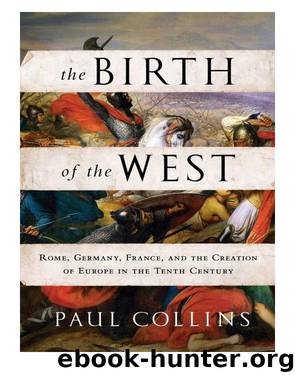The Birth of the West by Paul Collins

Author:Paul Collins
Language: eng
Format: epub
Publisher: PublicAffairs
Published: 2013-01-16T16:00:00+00:00
For the Romans, Caledonia, or Scotland, was beyond the borders of the known world. But for seven years beginning in AD 77 under the command of the very able governor of Britain, Sextus Calpurnius Agricola, some 5,000 troops of the Ninth Legion fought their way across what we now call Scotland. In 83 the Ninth faced some 30,000 Caledonii, seminaked men with red hair and body tattoos wearing brightly colored tartan trousers, at a place the Romans called Mons Graupius, most likely Bennachie, a breast-shaped mountain about 20 miles (32 kilometers) east of Aberdeen. The result was a rout. Possibly 10,000 Caledonians died, with only 360 Roman casualties. However, though Romans won the battle, they nevertheless lost the war.
Political expediency saw Agricola recalled. The Romans withdrew south to Hadrian’s Wall, which ran 72 miles (117 kilometers) across Britain from Newcastle-on-Tyne to Carlisle. In 159 the Romans sallied forth again into Caledonian territory to build the Antonine Wall from the Forth to the Clyde. This defensive line was soon abandoned, and the Romans permanently withdrew to Hadrian’s Wall until they abandoned Britain altogether in 410 as the Western Empire collapsed. The Romans called the Caledonians Picti, probably meaning “painted men” from the tattoos, and the name stuck.
Roman Britain had become largely Christian in the fourth century. After the Romans left, the British Christian communities that remained began sending missionaries to the Celtic peoples, the most famous of all being Saint Patrick in Ireland. Christianity also spread northward—we know there was a Christian community at Whithorn on the Scottish Galloway coast by the mid-fifth century. According to Bede’s Ecclesiastical History, a British bishop named Ninian built his monastery and candida casa (white house) there. The west coast of Scotland had close contact with Ireland, and Christianity soon spread across the northern Irish Sea, with the monk Columcille, or Columba in Latin, founding the monastery of Iona off the Isle of Mull. Columba later went on peregrinatio, a kind of voluntary exile, wandering through Scotland and contacting the Picts of northeastern Scotland around Inverness and Aberdeen. He met the Pictish king Bridei (555–584), who may have already have been a nominal Christian and whose death is recorded in the Annals of Ulster.24 Another missionary was the Christian Scot Kentigern or Mungo, who became a monk and was active around present-day Glasgow.
By the early ninth century Scotland was an amalgam of tribal peoples, most of them Christian, still living in an Iron Age economy. Picts lived in the Highlands and the area northeast of the Firth of Forth, and the Christian Gaelic (Irish) kingdom of Dalriada was in Argyll and the isles and was linked to County Antrim in northeast Ireland. There were also groups of Celtic Britons in the borderlands of the north. One British group occupied Cumbria and Westmorland, whose king Urien Rheged (ca. 530–590) was a Christian, and another made up the kingdom of Strathclyde, which centered on the rock of Dumbarton on the Firth of Clyde near Glasgow. In the seventh century the Anglo-Saxons pushed as far north as the Firth of Forth.
Download
This site does not store any files on its server. We only index and link to content provided by other sites. Please contact the content providers to delete copyright contents if any and email us, we'll remove relevant links or contents immediately.
Kathy Andrews Collection by Kathy Andrews(10521)
The remains of the day by Kazuo Ishiguro(7551)
Spare by Prince Harry The Duke of Sussex(4199)
Paper Towns by Green John(4169)
The Body: A Guide for Occupants by Bill Bryson(3802)
Be in a Treehouse by Pete Nelson(3214)
Harry Potter and the Goblet Of Fire by J.K. Rowling(3046)
Goodbye Paradise(2964)
Never by Ken Follett(2884)
Into Thin Air by Jon Krakauer(2703)
The Remains of the Day by Kazuo Ishiguro(2620)
The Genius of Japanese Carpentry by Azby Brown(2609)
The Cellar by Natasha Preston(2595)
Drawing Shortcuts: Developing Quick Drawing Skills Using Today's Technology by Leggitt Jim(2532)
120 Days of Sodom by Marquis de Sade(2439)
Architecture 101 by Nicole Bridge(2351)
The Man Who Died Twice by Richard Osman(2300)
Machine Learning at Scale with H2O by Gregory Keys | David Whiting(2293)
Fairy Tale by Stephen King(2071)
